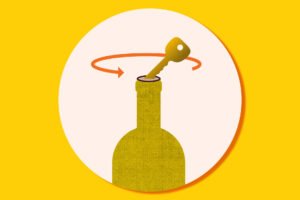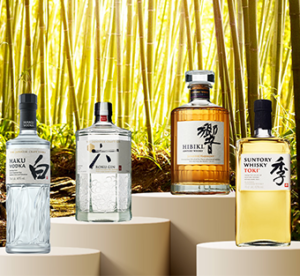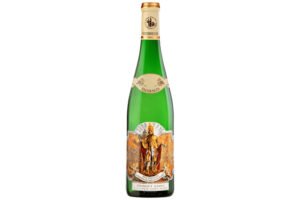Chile’s Old Cabernet Vines Make Their Debut

[ad_1]

© Lapostolle
| Owner Alexandra Marnier Lapostolle gets amongst the La Parcelle 8 vines.
Despite the international popularity of Cabernet Sauvignon, the world has very few old vineyards of it. Most Cabernet vineyards are replanted after about 30 years. Exceptional vineyards might last 50 years.
Thus I was excited to learn about a new wine being released by Chile’s Lapostolle winery: La Parcelle 8, which comes from a single vineyard of ungrafted pre-phylloxera vines that, in theory, date to the 1800s. In theory, this is the oldest Cabernet Sauvignon vineyard in the world.
The winery doesn’t make the latter claim for a couple of reasons. One, who knows what’s planted elsewhere? But the Old Vine Register maintained by Jancis Robinson lists only one potential contender, in Barossa Valley, in its database of hundreds of vineyards in 20 countries. There are plenty of surviving vineyards from the 1800s, but they are of other grape varieties, especially Carignane, Grenache, Zinfandel and Mission (País). Austria has Gruner Veltliner from the 1800s; Germany has Riesling that old. South Africa has a vineyard that dates to the 1700s. But nobody has kept a Cabernet Sauvignon vineyard going that long.
The second reason Lapostolle doesn’t make the claim is the same reason France doesn’t have as many old vineyards as you’d think. Since purchasing the vineyard in 1994, the owners, who came from France, have practiced marcottage, a French method of propagation in which new vines are grown by burying a live cane in the ground to take root and sprout a new vine. The Lapostolles haven’t torn up the La Parcelle 8 vineyard and replanted it, but there are newer vines that literally sprouted from older ones. So it does beg the question of whether the vineyard is actually “older” than, say, a vineyard planted in the 1970s that has not been revitalized in this way.
“Can we really say that a vineyard is 100 years old?” said Charles De Bournet, son of the winery’s founders and now general manager. “We do marcottage. We lose 3 percent of our vines every year. So after 33 years, your entire vineyard is regenerated. At the end of the day, that’s always interesting when you talk about how old a vineyard is. We have a pergola that is huge of País. We estimate that the vines are 150 years old. This vineyard is harder to classify.”
Nonetheless. Old Cabernet vineyards are rare for a reason. In Bordeaux, there are strict opinions on vine age: many top châteaux don’t put fruit from young vines in their flagship wine, but they also regularly replant their vineyards when productivity drops, generally at about 35 years. That philosophy went with French vignerons around the world to places where Cabernet was planted, and Cabernet wasn’t a popular variety outside Bordeaux until well after World War II. For example, while California has a number of century-old Zinfandel vineyards, state growers weren’t really interested in planting Cabernet until the 1970s; a lot of great Napa Cab vineyards are just reaching 50 years old now.

© Lapostolle
| The vines of Clos Apalta could be among the oldest in the world.
Finding treasure
So it was stunning for Alexandra Marnier Lapostolle and her husband Cyril de Bournet to discover the elderly parcel in Apalta Valley while they were scouting a location for the Chilean winery they wanted to found. Their main business was Grand Marnier; they also owned Château Sancerre, but have since sold both.
“My parents, when they entered the valley and they saw these old vines, they knew if these vines could survive alone here, there was no irrigation, if the vines can survive alone, you have a really special terroir where the vine can live in harmony with nature,” De Bournet told Wine-Searcher.
“Apalta in local language means ‘bad soil’,” De Bournet said. “It couldn’t grow much, so that’s why (locals) started growing vines there. Apalta is a place where you have maybe 50 hectares of vines from 1920. Some from 1909. But we don’t have any proof. Nobody was saying, this was planted at that time.”
The family created Clos Apalta as its flagship wine. It’s a Bordeaux blend, but Cabernet Sauvignon is not the leading player; it usually has more of both Carmenere and Merlot. Clos Apalta was the focus, and the Parcelle 8 grapes went into it.
“When you look at what Apalta was in ’94, there wasn’t even a road,” De Bournet said. “There was a little dirt road to go to this vineyard. Now it’s one of the most prestigious places in South America.”
In 2013, De Bournet took over the winery from his parents, and decided he wanted to release the Parcelle 8 wine as a single-vineyard Cabernet.
“It’s so humbling for us to work with those vines,” winemaker Andrea León told Wine-Searcher. “They really are well balanced. They can adjust to the difference in vintage very early in the season. You don’t have to do much of a green harvest. You have to be very specific about how you prune them. We just add a little bit of sulfur for oidium, and some organic oil for the red spider. They don’t have much canopy. They always have very balanced numbers. They don’t go crazy high alcohol. They don’t get low. They have lots of acidity. They show the granite soil they are planted on.”
“We try to do as little as we can,” León said. “We separate (the grapes) from the stems. We do a little very gentle crush. We have a beautiful winery with small French oak vats. We don’t want either too hot or too cold. Very slow fermentation. We don’t press them or hurry them. We look after them in terms of temperature. Sometimes we use the press; sometimes we don’t. They go into a mix of new French oak and some old oak. Then we just wait.”
Wait is the right word: the first release of this wine, this year, is from the 2015 vintage.
“We’re not in a hurry,” De Bournet said. “That’s why we’re releasing the ’15. People don’t really age wines anymore. I think this wine can age beautifully. If I had released it in ’17, everything would be drunk by now. I really want to show the potential. Chile suffers from this reputation that our wines cannot age. I think it’s false. I think these wines are the proof that if you do things right, these wines can age as well as any first-growth Bordeaux.”
The wine is fairly dense and benefits from decanting or time in the glass. You can tell why the extra age was called for: even with ripe dark fruit from long hang time, the tannins are formidable. It has good length and some nice violet and slate notes on the nose, but if you buy it, consider cellaring it for another 5-10 years or more.
“We might release the ’14 next, or some time the ’17,” De Bournet said. “It’s such a small production: less than 12,000 bottles. We have the luxury to do what we want. These are old vines. They don’t produce 8000 kilos per year every year. ’15 was a beautiful year, we have a lot of wine, but ’16, ’17 and ’18 were not the same. We don’t have as much wine. One thousand cases of a wine that’s over $100 in the US, it’s quite a lot. I was not expecting to sell it that fast. We were out of stock in less than three weeks.”
To join the conversation, comment on our social media channels.
[ad_2]




